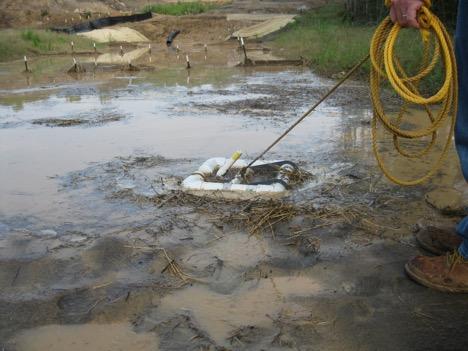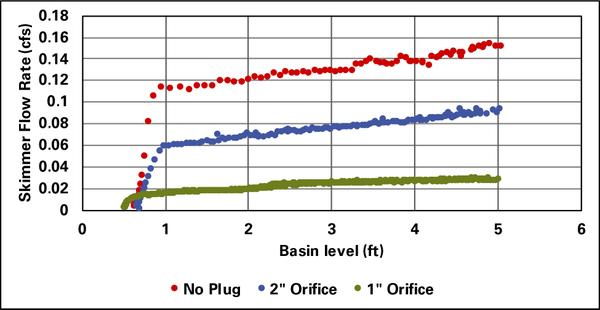Sediment basins are a temporary stormwater practice designed to pool runoff in order to collect and deposit a portion of the sediment it carries. One way to improve the sediment capture rate is to use an outlet that removes water from the top of the basin’s water column. That is effective because the water there has the least amount of sediment due to settling. This practice is now required in most states, including North Carolina. This factsheet describes various ways to accomplish this goal.
There are essentially two options for dewatering sediment basins from the surface. The simplest is to simply let the basin fill and overflow into a riser or over the dam through a stable weir. The problem with this approach is that the basin remains full between storms, which can be a hazard. This approach also creates problems in removing the accumulated sediment or even identifying when it needs to be removed. As a result, there are a number of skimmer options that dewater from the surface but also drain the basin slowly over several days after a storm.
Skimmer Basics
Skimmers have some common features that allow them to slowly drain a basin. They have some form of float that holds up an outlet pipe near the water surface, often several inches below to avoid floating debris (Figure 1). That pipe is connected to a flexible hose or joint attached to a pipe through a dam or near the bottom of a riser structure. The flexible joint allows the skimmer to rise and fall. The basin water exits through the outlet pipe and into the dam or riser pipe and out of the basin at a rate designed to empty the basin in two to three days. Several manufacturers provide tables of flow rates for different-sized skimmers to help in choosing the right-sized skimmer to achieve the desired drain rate. Some models also come with plastic plugs that can have different-sized holes to reduce the flow rate for that particular skimmer in order to allow it to be used on smaller basins. One skimmer has slots with an adjustable sleeve to open up more or less slot area to adjust the drainage rate.
Using a skimmer outlet on a basin offers a number of benefits. These include:
-
Allowing extra time for the sediment to settle as the basin is slowly drained.
-
Because flow into the basin is usually greater than flow out of the skimmer, it quickly creates a pool of water in the basin as it fills, which helps the water to slow and the sediment to drop out.
-
The skimmer can be used over and over by replacing the plugs to change the discharge rate as the basin size changes.
Figure 1 shows a number of important installation considerations. If the skimmer is attached to a pipe through an earthen dam, there should be an anti-seep collar on the pipe within the dam to prevent flow along the pipe. At the outlet, there should be an erosion control blanket or other device to prevent scouring as the water leaves the pipe. As shown, the pipe can be installed above the bottom of the basin, which will create a standing pool. This approach will keep the skimmer floating once the water level drops to the pipe level, which in turn keeps it from potentially getting stuck in the mud on the bottom. In addition, standing pools have been demonstrated to increase sediment capture by the basin by diffusing the energy in the first flush of runoff. Finally, a rope should always be attached to the skimmer in order to pull it to the side and clean it periodically, as shown in Figure 2. Attach the rope to a stake or a similar secure place on the side of the basin.
There are a number of skimmers with different features and designs on the market (Figure 3). They usually come in different sizes for a range of basin volumes, with additional adjustments possible on the skimmer using flow restrictor plugs. The manufacturers provide the information needed to get the correct drawdown rate, usually with a goal of emptying the basin to the desired level in two to three days. Figure 4 shows an example of how different-sized orifices change the flow rate.
Resources
North Carolina Department of Environmental Quality. “Erosion and Sediment Control Planning and Design Manual.”
North Carolina Department of Transportation. “Skimmer Basin with Baffles.”
North Carolina Department of Transportation. “Earthen Dam with Skimmer.”
North Carolina Department of Transportation. “Erosion and Sediment Control Design and Construction Manual.” 2015.
Publication date: May 2, 2019
Reviewed/Revised: Feb. 15, 2024
AG-439-65
N.C. Cooperative Extension prohibits discrimination and harassment regardless of age, color, disability, family and marital status, gender identity, national origin, political beliefs, race, religion, sex (including pregnancy), sexual orientation and veteran status.




